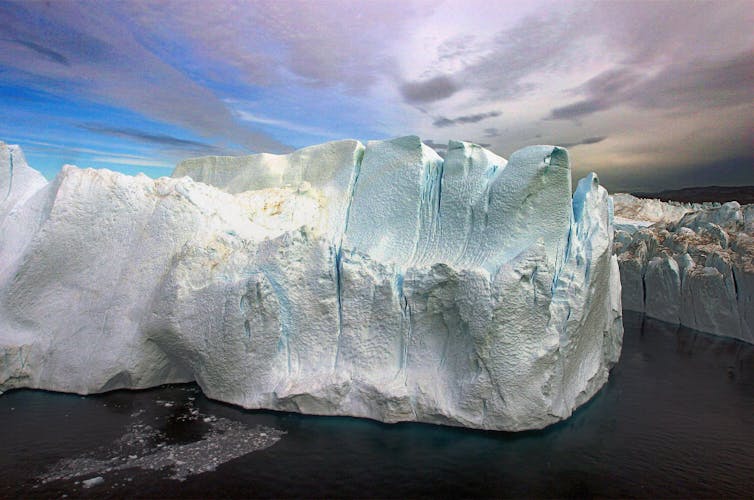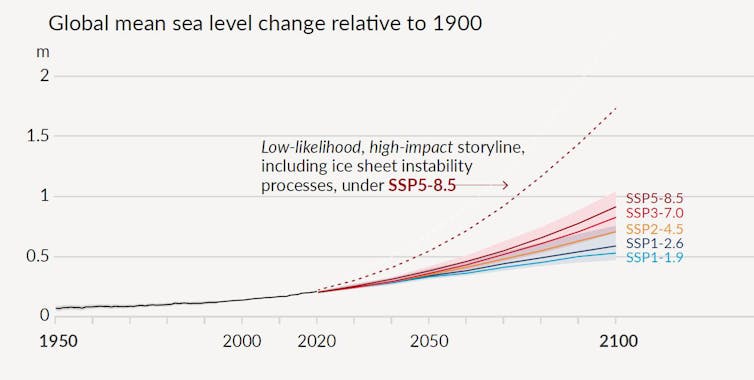What if all of the W. Antarctic Ice Sheet were to melt?
The Antarctic ice sail is the largest mass of ice in the world, holding around 60% of the earth's fresh h2o. If it all melted, global boilerplate ocean levels would rising past 58 metres. But scientists are grappling with exactly how global warming will affect this peachy water ice sheet.
This knowledge gap was reflected in the latest report from the Intergovernmental Panel on Climate Change (IPCC). It contains projections from models in which important processes affecting the ice sheets, known as feedbacks and tipping points, are absent-minded because scientific understanding is lacking.
Projected sea level rise will have widespread effects in Commonwealth of australia and effectually the earth. But current projections of ice canvas melt are and so broad that developing ways for societies to arrange volition be incredibly expensive and hard.
If the world is to effectively adapt to sea level rise with minimal toll, nosotros must rapidly address the uncertainty surrounding Antarctica's melting ice sheet. This requires significant investment in scientific capacity.

The great unknown
Water ice loss from the Antarctic and Greenland ice sheets was the largest correspondent to body of water level rise in recent decades. Even if all greenhouse gas emissions ceased today, the estrus already in the bounding main and atmosphere would cause substantial ice loss and a respective rise in body of water levels. But exactly how much, and how fast, remains unclear.
Scientific understanding of ice sheet processes, and of the variability of the forces that affect ice sheets, is incredibly limited. This is largely considering much of the water ice sheets are in very remote and harsh environments, and then hard to admission.
This lack of information is one of the main sources of uncertainty in the models used to estimate water ice mass loss.
At the moment, quantifying how much the Greenland and Antarctic ice sheets volition contribute to bounding main level rise primarily involves an international scientific collaboration known equally the "Ice Canvass Model Intercomparison Project for CMIP6", or ISMIP6, of which we are part.
The project includes experts in water ice sheet and climate modelling and observations. It produces computer simulations of what might happen if the polar regions melt under different climate scenarios, to improve projections of sea level rise.
The project likewise investigates ice sheet–climate feedbacks. In other words, information technology looks at how processes in the oceans and atmosphere will affect the Antarctic and Greenland water ice sheets, including whether the changes might crusade them to plummet – leading to large and sudden increases in sea level.
Baca juga: Anatomy of a heatwave: how Antarctica recorded a 20.75°C mean solar day final month

Melting from beneath
Enquiry has identified so-chosen "basal melt" every bit the well-nigh significant commuter of Antarctic ice loss. Basal melt refers to the melting of ice shelves from underneath, and in the case of Antarctica, interactions with the ocean are thought to be the principal cause. But gathering scientific observations beneath ice shelves is a major logistical claiming, leading to a dearth of information about this phenomenon.
This and other constraints mean the rate of progress in water ice sheet modelling has been bereft to date, and and then active water ice sheet models are not included in climate models.
Scientists must instead make projections using the ice sheet models in isolation. This hinders scientific attempts to accurately simulate the feedback between ice and climate.
For case, it creates much dubiety in how the interaction between the ocean and the water ice shelf will touch on ice mass loss, and how the very common cold, fresh meltwater volition make its fashion dorsum to global oceans and cause sea level rise, and potentially disrupt currents.
Despite the uncertainties ISMIP6 is dealing with, it has published a series of contempo research including a key newspaper published in Nature in May. This found if the world met the Paris Understanding target of limiting global warming to i.five℃ this century, land ice melt would cause global sea level rising of nearly 13cm by 2100, in the virtually optimistic scenario. This is compared to a ascension of 25cm under the earth'south current emissions-reduction pledges.
The written report also outlines a pessimistic, but still plausible, basal cook scenario for Antarctica in which ocean levels could be v times higher than in the main scenarios.
The latitude of such findings underpinned sea level projections in the latest IPCC report. The Antarctic ice sheet one time once again represented the greatest source of uncertainty in these projections.
The below graph shows the IPCC's latest sea level projections. The shaded area reflects the big uncertainties in models using the same bones data sets and approaches. The dotted line reflects deep incertitude about tipping points and thresholds in ice sheet stability.
IPCC reports are intended to guide global policy-makers in coming years and decades. But the uncertainties most ice melt from Antarctica limit the usefulness of projections by the IPCC and others.
Baca juga: This is the most sobering written report menu nevertheless on climatic change and Earth's future. Here's what you need to know

Dealing with uncertainty
Future sea level rise poses big challenges such as human displacement, infrastructure loss, interference with agriculture, a potential influx of climate refugees, and coastal habitat degradation.
Information technology'southward crucial that water ice sail models are improved, tested robustly confronting real-world observations, and then integrated into the next generation of international climate models – including those beingness developed in Australia.
International collaborations such as NECKLACE and RISE are seeking to coordinate international effort between models and observations. Significant investment across these projects is needed.
Sea levels volition continue ascension in the coming decades and centuries. Ice sheet projections must be narrowed downward to ensure current and future generations tin can adapt safely and efficiently.
The authors would like to acknowledge the contributions of Dr Ben Galton-Fenzi, Dr Rupert Gladstone, Dr Thomas Zwinger and David Reilly to the research from which this article draws.
Source: https://theconversation.com/scientists-still-dont-know-how-far-melting-in-antarctica-will-go-or-the-sea-level-rise-it-will-unleash-166677
Postar um comentário for "What if all of the W. Antarctic Ice Sheet were to melt?"